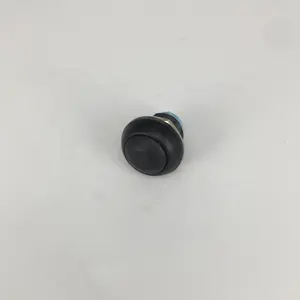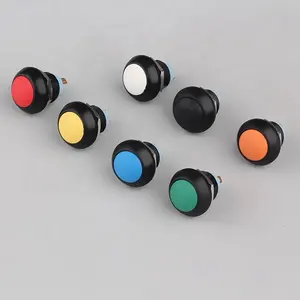
All categories
Featured selections
Trade Assurance
Buyer Central
Help Center
Get the app
Become a supplier

(1020 products available)



























Waterproof trigger switches come in diverse types, each tailored to specific needs and environments. Understanding these variations can increase effectiveness and longevity in challenging settings.
These switches necessitate human activation; thus, they are notable for their durability. Often employed in industries where hand operations are normal, the manual activation helps assure control even in wet settings.
Foot switches provide hands-free operation, allowing users to activate machinery by foot. These are often found in manufacturing, medical, and audio-visual industries where hands might be occupied.
These switches are designed for digital systems. They are often sensitive and can be triggered by minimal electronic impulse. These switches can handle triggering under extreme wetness, making them essential for marine or outdoor electronics.
A hydraulic waterproof trigger switch denotes pressure or flow change in a fluid-filled system, which is typically utilized in machinery and equipment where electronic switches may fail due to wetness or debris.
The longevity and performance of waterproof trigger switches depend on the quality of materials used in their construction, as well as the design considerations that ensure reliability in tough environments.
Switch casings are constructed using thermoplastics such as polycarbonate and glass-reinforced nylon. Metal enclosures commonly created from aluminum or stainless steel can also be used in design. These materials are sturdy and protect the inner parts from water and debris.
Sealant plays a critical role in providing waterproof features. Common technologies include O-rings, lip seals, and potting compounds. O-rings are usually located in a switch's critical access points to create a tight seal that inhibits water entry. Lip seals work as barriers that stop water and dust from penetrating the switch. Potting embeds the sensitive parts of a switch in resin to shield them from water and physical harm. This sealant is commonly used in waterproof button switches to secure their functionality in extreme conditions. The potting function is executed mainly on switches used in marine and industrial applications.
Several switches display ratings that show their capacity to stand splash, saltwater, and chemical exposure. These features typically include additional corrosion protection, such as coatings or stainless steel parts. Oceanographers, maritime engineers, and outdoor equipment manufacturers greatly appreciate this certification.
Waterproof trigger switch contact materials greatly impact conductivity and resistance to corrosion. Common contact materials comprise gold-plated contacts, silver alloys, and copper beryllium. Gold-plated contacts are corrosion-resistant and highly reliable, ensuring long-term stability in performance. Silver alloys are preferred for high-current operations because of their excellent electrical conductivity and durability. Copper beryllium strikes a balance between cost and performance. Its inherently corrosion-resistant properties make it ideal for marine and outdoor settings.
Waterproof trigger switches are vital components in many industries and contexts, as their capacity to withstand harsh environmental conditions assures dependable performance.
Waterproof trigger switches are designed in marine and offshore industries to withstand water, salt, and extreme weather. These switches control equipment like boats, ships, and offshore drilling rigs and ensure operation in severe conditions.
In these industries, waterproof trigger switches activate machinery in wet or dusty environments like food processing, wastewater treatment, and mining. Their durability guarantees reliable operation in hazardous settings.
In this sector, these switches are used in equipment requiring cleaning and disinfection, such as surgical tools and diagnostic devices. Their waterproof feature ensures they endure sterilization processes without malfunctioning.
Waterproof trigger switches are vital in outdoor and military applications, from handheld devices to heavy machinery. They ensure communications, navigation, and field equipment function effectively in rain, snow, and extreme temperatures.
In these industries, waterproof trigger switches control crucial elements like lighting, wipers, and various systems in vehicles and aircraft exposed to precipitation. They ensure uninterrupted operation in poor weather and demanding environments.
These switches are important for emergency response vehicles and equipment, such as ambulances and fire engines, which work in unpredictable weather. It ensures that all gadgets function adequately during critical moments.
Choosing the right waterproof trigger switch for a client depends on several variables. These selection elements range from operational requirements to environmental conditions.
These factors determine what usage scenarios the switch will tolerate. Ingress protection rating reflects these tolerable scenarios. Ingress protection ratings show the extent to which the switch can resist moisture and debris.
Extreme weather situations involving heavy rains, humidity, or dust necessitate switches with higher waterproof ratings. For example, switch with an Ingress Protection (IP) rating of IP67 or higher for outdoor and marine applications. For industrial settings with dust or chemical exposure, switching with additional solenoid sealing or potting might be necessary.
Just like the environmental situation, the switches must be electrically compatible with the client’s system. This compatibility may involve matching voltages, current ratings, and signal types. Besides, consider the clients’ systems operating speeds and response times. Having a switch that aligns with the client's needs will boost operational efficiency.
If the client is acquiring these switches for production use, they will likely need a switch that lasts long and requires little maintenance. In such cases, choose switches with corrosion-resistant parts, high-quality contact materials, and robust housing. The enterprise's reliability and performance directly affect the total cost.
Clients may need custom-brand waterproof trigger switches to meet specific operational and business needs. Clients may also require different switch configurations, such as actuator styles, number of poles, and operating force.
Yes, there are switches specifically designed for extreme thermal environments. These switches maintain their sealing and operational integrity even in very high or low temperature zones.
Their rugged design leaves most of these switches easily maintainable. However, one must regularly inspect switches for signs of wear or damage. Corrosive environments might necessitate more frequent inspections. Also, cleaning switches with compressed air or brushes to remove any debris or corrosion build-up can help maintain them.
Not all waterproof trigger switches are corrosion-resistant. However, most switches meant for marine, outdoor, and industrial applications incorporate corrosion-resistant components.
Only switches with waterproof ratings for immersions, such as IP68 or greater, are suitable for submerged operations.
Ingress protection ratings are very important in these switches because they show the extent to which the switches can resist particulate and liquid ingress.